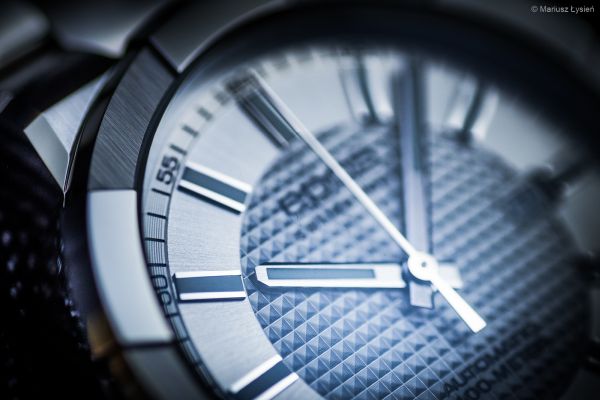Can Winding an Automatic Watch Damage the Mechanism?
Automatic watches are prized for their uniqueness and convenience compared to hand-wound mechanical watches. They function effortlessly by being worn, as wrist movements provide the energy required to power the watch. The mechanism relies on a rotor that moves with your wrist, driving a gear train that winds the mainspring. As the spring stores energy, it powers the watch for a certain period, known as the power reserve.
Manual Winding of Automatic Watches via the Crown
Many manufacturers include mechanisms that allow manual winding of automatic watches by turning the crown in one direction. This feature is especially common in mechanisms that come in various versions with different additional functions.
Does this mean you should always use it? It depends on the situation and your overall use of the watch. First, let’s review some practical aspects of automatic mechanisms.
Automatic Watches Are Designed for Wrist Movement
An automatic mechanism is fundamentally designed to be powered by wrist movements. Its intricate assembly of hundreds of components works optimally when energy is generated by the rotor rather than the crown. Therefore, it’s best to use the watch as intended. Ironically, manually winding an automatic watch may do more harm than good.
The Mechanism Has a Maximum Energy Capacity
The power reserve applies to all mechanical watches, meaning they can only store a specific amount of energy. Manually winding via the crown can cause excessive tension in the mainspring, potentially reducing its lifespan. Automatic mechanisms are designed to prevent this scenario during wrist movement, where certain components slip rather than over-tighten the spring.
Overworking the Mechanism Through Manual Winding
Manual winding forces the watch to work in ways it wasn’t optimized for. Instead of naturally cycling through winding and releasing energy, the mechanism remains perpetually wound, making the rotor’s operation redundant. This can lead to accelerated wear on various components.
When Should You Manually Wind an Automatic Watch?
Manual winding is helpful when the power reserve has been fully depleted, and you want to use the watch immediately. In such cases, carefully wind the watch by turning the crown 7–10 times back and forth, but avoid winding to its maximum capacity. Always consult the user manual to ensure proper operation, as some mechanisms don’t support manual winding.
How to Prevent the Mechanism from Stopping
The ideal solution is to prevent the watch mechanism from stopping. Wear your favorite automatic watches as often as possible! For those not worn regularly, consider using a watch winder. This device keeps the mechanism running and serves as a secure way to display your collection while maintaining optimal storage conditions.
4 Key Tips for Maintaining an Automatic Watch
- Temperature: Avoid exposing the watch to extreme temperatures, as they can damage internal components and alter the properties of protective lubricants.
- Magnetic Fields: Keep your watch away from electronics and magnetic devices, which may affect its accuracy by causing it to run fast or slow.
- Shocks and Vibrations: Avoid dropping or exposing the watch to strong vibrations, which can harm the balance wheel, mainspring, or gear train.
- Regular Servicing: Have your automatic watch serviced every 3–5 years to maintain its longevity.
A quality watch can accompany you for years or even decades if properly cared for. We hope this guide helps you keep your timepiece in peak condition. Ready to expand your collection? Explore our range of automatic watches today!
See popular articles

Dlaczego zmieniamy czas na zimowy w zegarkach? Tłumaczymy mechanizm i historię zmiany czasu
Dwa razy w roku cofamy lub przesuwamy wskazówki zegara, ale rzadko zastanawiasz się, po co właściwie jest zmiana czasu i dlaczego wciąż jej przestrzegamy. To nie tylko kwestia tradycji – za tym zwyczajem stoi historia, decyzje polityczne i próba lepszego wykorzystania światła dziennego. Sprawdź, jak działa mechanizm przestawienia czasu, skąd się wziął i jakie ma znaczenie dziś.

Zegarki solarne - ranking ciekawych modeli i wszystko co warto wiedzieć przed zakupem
Zegarki solarne to nowoczesne połączenie stylu i praktyczności – zasilane światłem, niezawodne i przyjazne środowisku. Dzięki wbudowanym panelom solarnym nie wymagają regularnej wymiany baterii, co czyni je wyjątkowo wygodnymi w codziennym użytkowaniu i bardziej ekologicznymi. W naszym rankingu znajdziesz modele, które wyróżniają się nie tylko atrakcyjnym designem, ale również bogatą funkcjonalnością i imponującą trwałością, idealne dla wymagających użytkowników poszukujących zegarka na lata.

Jak zmienić czas na zimowy w Casio G Shock?
Zmiana czasu potrafi zamieszać – nie tylko w głowie, ale i na nadgarstku. Jeśli nosisz G-Shocka i chcesz szybko przestawić go na czas zimowy, nie musisz zagłębiać się w instrukcje ani zgadywać, który przycisk za co odpowiada. W tym poradniku znajdziesz konkretne wskazówki, proste kroki i sprawdzone triki, które pomogą Ci bez nerwów ustawić zegarek Casio G-Shock – niezależnie od modelu, który masz.

Jak dobrać biżuterię do zegarka? Zasady, inspiracje i gotowe triki stylizacyjne
Dobranie biżuterii do zegarka to nie tylko kwestia gustu, ale przede wszystkim umiejętność stworzenia spójnej, stylowej całości. Zegarek może być subtelnym tłem dla dodatków albo główną ozdobą, wokół której budujesz cały look. Sprawdź, jak łączyć metale, wybierać bransoletki i tworzyć zestawienia, które zawsze wyglądają elegancko i nowocześnie.

Jaki zegarek na 40 urodziny wybrać? TOP 5 wyborów
Czterdzieste urodziny to wyjątkowy moment – symboliczny etap życia, w którym zegarek może stać się nie tylko praktycznym dodatkiem, ale także wyrazem stylu, statusu i osobowości. Zegarek na 40 urodziny powinien podkreślać dojrzały gust, elegancję oraz indywidualność obdarowanego – kluczowe znaczenie ma jakość, prestiż marki oraz funkcjonalność dopasowana do codziennych aktywności Poniżej przedstawiamy TOP 5 zegarków męskich na 40 urodziny dostępnych w ofercie sklepu WestWatches – zapraszamy!

Jaki zegarek kupić na dzień chłopaka? TOP 6 propozycji od West Watches
Dzień Chłopaka to świetna okazja, aby podarować coś wyjątkowego – prezent, który będzie nie tylko praktyczny, ale i symboliczny. Zegarek to zawsze trafiony wybór – elegancki, funkcjonalny i trwały. Ważne jednak, by dopasować go do stylu oraz trybu życia obdarowywanego. Czy woli klasyczną elegancję, sportowy look, a może nowoczesne technologie? Poniżej znajdziesz sześć propozycji z oferty WestWatches.pl, które sprawdzą się jako idealny prezent.

Czym jest bezel zegarka? Wyjaśniamy jego zastosowanie i zalety
Bezel to detal, który często umyka uwadze, a w rzeczywistości decyduje o funkcjonalności, stylu i bezpieczeństwie zegarka. To właśnie ten pierścień sprawia, że czasomierz staje się czymś więcej niż tylko ozdobą na nadgarstku. Dowiedz się, co to jest bezel w zegarku, jak działa i do czego możesz go wykorzystać na co dzień.

Tachometr - co to jest i jaką funkcję pełni w zegarku?
Tachometr w zegarku to coś więcej niż ozdobna skala na tarczy – to praktyczne narzędzie, które pozwala w kilka sekund obliczyć średnią prędkość na wybranym dystansie. Choć dziś korzystasz z GPS-u, ta klasyczna funkcja nadal ma swój urok i znaczenie, łącząc precyzję z historią zegarmistrzostwa.

Bransoleta mesh - czym jest i do jakich stylizacji pasuje?
Jeśli szukasz dodatku, który połączy wygodę codziennego noszenia z elegancją biżuterii, bransoleta mesh może być strzałem w dziesiątkę. Ten charakterystyczny, mediolański splot od lat zdobywa uznanie zarówno wśród miłośników klasycznych zegarków, jak i fanów nowoczesnych smartwatchy. Zanim zdecydujesz się na zakup, sprawdź, co dokładnie oznacza ten typ bransolety, jakie są opinie użytkowników i w jakich stylizacjach sprawdza się najlepiej.











